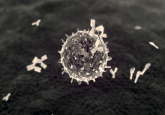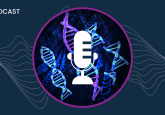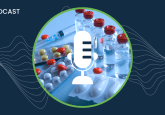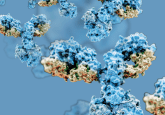The new frontier: regulatory implications for cell and gene therapies
In the first episode of The new frontier podcast, we spoke to Executive Director and Global Head of Regulatory Services Kimberley Buytaert-Hoefen about her experience with cell and gene therapy (CGT) approvals and the barriers to getting these important therapeutics to the patient. Kim advises early regulatory interaction and collaboration to improve the success rate of applications and emphasizes the importance of global harmonization of regulatory standards. We discuss key barriers to CGT approvals including manufacturing and immunogenicity and Kim voices her excitement for the newly approved CRISPR-Cas9 technology to treat sickle cell disease.
Podcast transcript
[00:07] Ellen Williams: Hello and welcome to the first episode of the Bioanalysis Zone podcast on Cell and Gene Therapies, sponsored by QPS Holdings. I’m your host, Ellen Williams, and today I am joined by Kimberley Buytaert-Hoefen, Executive Director and Global Head of Regulatory Services from QPS. Welcome to the podcast, Kimberley.
[00:25] Kimberley Buytaert-Hoefen: Thank you.
[00:26] Ellen Williams: Kim, we have spoken to you a little bit before about cell and gene therapies, but for those just joining the conversation, would you like to tell us a little bit more about your work in the field?
[00:35] Kimberley Buytaert-Hoefen: All right. Well, thank you for this opportunity. A little bit about my background, my training in neuroscience. I worked in early gene therapy, siRNA in Tom Cech’s laboratory, I’ve worked in adult stem cells, embryonic stem cells, and this was all about 20 years ago. So, what we struggled with through the years is actually getting these products, being able to manufacture GMP, and showing that they are safe and effective, very exciting that we are there now.
[01:05] Kimberley Buytaert-Hoefen: My time spent in between, I worked in industry in biologics and then I worked as a field investigator for the FDA. During this time biosimilars came into place, which was very exciting being able to get those biological products to patients in an affordable manner. As I went into consulting, then we had our first gene therapy product for approval, followed by CAR-T. I worked on both of those first approved products, and then I specialized in quality in regulatory areas for gene and cell therapies, expedited programs as well, trying to get those products to the patients faster.
[01:48] Ellen Williams: It feels like cell and gene therapies have really gone on a very exciting journey over the last 10 or 20 years. There’s been so much progress, but if we start from the very, very basics, what are we talking about when we talk about cell and gene therapies? What does that encompass?
[02:04] Kimberley Buytaert-Hoefen: So first we need to understand what the genetic defect is in a disease state. Once we can pinpoint that, then we work toward correction. So, there’s different types with cell and gene therapy, but the foundation is the plasmid. The plasmid that is going to correct this genetic defect. If we look at gene therapy, then we are able to take a plasmid and have a route of delivery, so maybe viral, maybe a lipid, into a cell to correct that genetic defect.
[02:39] Kimberley Buytaert-Hoefen: Then there’s cell therapy. So we are going to take the cells out of the body and we are going to use that plasmid, and also, once again, we need that vector to be able to deliver it to the cells but treat the cells outside of the body and then transfer them back into the body of the same person, or the newer technologies are even going toward more of the off-the-shelf. So, we are able to remove any kind of immunogenicity of the cell and give it to a different person. So that is the future, and that’s a very exciting time for us.
[03:20] Ellen Williams: So we are starting to see these kind of, was it off-the-shelf that you used there, that phrase? So we are starting to see these actually be very accessible to people. What is involved in the regulatory approval in the lead-up to being able to access those cell and gene therapies off-the-shelf, and why is that process so important?
[03:40] Kimberley Buytaert-Hoefen: The regulatory approval pathways, they really are unique toward the product. We have some standard platforms such as CAR-T that we have seen coming through, also standard manufacturing platforms, but a lot of the other cell therapies and gene therapies are very unique. So, what we encourage is early regulatory interaction. We start with early engagement meetings with the agency, interact pre-IND so we are aligned. We are aligned on: what are the release specifications? How are we going to manufacture this product? Have we done all of the preclinical work? Have we thought of everything that needs to be considered to go into first in human and all the different phases of the clinical trial?
[04:33] Kimberley Buytaert-Hoefen: You really want to start early and get that alignment so that when you go to apply your regulatory applications that you will be successful. The regulatory agencies want to work with you. It is a collaboration, and the goal is safe and effective to patients. In this space, it is a lot of rare diseases with no treatment options. It is an opportunity for expedited programs throughout the regulatory pathway, starting with fast track, breakthrough once you get the early clinical efficacy data, contingent approval, expedited review, many, many opportunities, and so really do not want to work alone. You want to engage them as early as possible. And also, we are seeing a lot of global harmonization, especially with the EU, the US, and Japan, as far as what should these standards be, how do we show that they are safe and effective, and how can we work together to be able to review these applications and also facilitate them to the patients.
[05:46] Ellen Williams: I guess this might differ quite drastically between the different types of cell and gene therapies going through approvals, but generally how long do the approvals take?
[05:56] Kimberley Buytaert-Hoefen: Well, a typical small molecule or biologic, you are probably looking at 7 to 11 years. With these expedited programs, we can reduce them down to 5 to 7 years. Really, it is ethically the right thing to do to get it to the patient faster. So, we want to be sure to work with the regulatory agencies and use these expedited pathways. Also with rare diseases, there’s incentive programs to produce these products for patients. A lot of these products are small batch, so as far as profitability, it is not manufacturing large scales. It is very expensive products, but you will never be manufacturing large scale products. So, it is really nice that we have these rare disease incentive programs that encourage companies to bring these products to market.
[06:56] Ellen Williams: During that length of time then, what are some of the common barriers that you maybe seeing to getting those cell and gene therapies approved?
[07:04] Kimberley Buytaert-Hoefen: The biggest barriers to getting these products to market, number one is manufacturing. Manufacturing these products, if you are in expedited programs, it is going to move faster than your common scaling up of manufacturing. Putting that extra burden on the GMPs for the product, it becomes difficult. So, we really want to work to have that clinical data and the manufacturing data available for the approval of a marketing authorization. Another issue is with immunogenicity. We do not really know what will happen over time with the products. This needs to be monitored with long-term monitoring. Developing analytical methods can be a challenge. You want to show the mechanism of action through a bioassay and want to show in lots of cases, protein expression. You want to be able to quantitate the gene.
[08:10] Kimberley Buytaert-Hoefen: Biomarkers! Biomarkers are huge for these types of products because depending upon when you initiate the treatment, you can see early changes in biomarkers before you can see the changes in the efficacy for the disease. And if the disease has already progressed to a certain state, you cannot reverse it. You can only treat it going forward. So, biomarkers are going to show that you are causing the gene to work correctly earlier than you are going to see those physical corrections of the disease or actually the stopping of the progression of the disease.
[08:56] Ellen Williams: So what are you seeing to be the most common cell and gene therapies coming through regulatory approvals right now and do you envision those maybe being slightly different in years to come?
[09:09] Kimberley Buytaert-Hoefen: In the beginning, we started with gene therapy that had the route of administration through the eye. The eye being an exposed organ, we are able to get that efficacy and show safety with these products in a human being. Then we moved on to cellular therapies, CAR-T, where we are taking the cells out, treating the cells, and putting the cells back, and this was really building on the bone marrow transplant history that was started in the 50s. So, we are progressing, but now what is the next step?
[09:46] Kimberley Buytaert-Hoefen: We need to move beyond CAR-T and the early gene therapies. We have the siRNAs that are coming out now that are really target specific. One thing with that, it is commonly chronic administration. So that even changes what we are seeing traditionally with gene and cell therapy. So, it is a transient treatment. With gene and cell therapies, it is a one-time treatment; one-time treatment: potential cure. So that is really exciting. And then where is that one going? We are already seeing hematopoietic stem cells in the industry commercialized. The next one is the mesenchymal cells. So, we are going to go a little bit earlier up in that pathway, being able to differentiate into even more types of cells. The off-the-shelf, so having universal donors where we can expand those cells, keep them frozen, remove anything that would cause any kind of immunological reaction, and then do customized treatments, individualized treatments for patients, depending upon what is their defect.
[11:05] Kimberley Buytaert-Hoefen: So that is a very exciting time for the industry. We have a lot of natural history studies. So, you go in and fully understand what a certain rare disease, what are the biomarkers? You are going to take samples from the disease patients and understand the disease. And then you are going to understand what you can use, when you find the products that will treat it, when you find that gene-insult therapy that will treat the defect. Now you know what the biomarkers are and what you can measure. So, the natural history studies are the beginning, and then we move on to the treatment. We are seeing a lot more of decentralized studies with rare diseases. There is a lot of burden on the patient. Rare diseases are often in children. So we have children, we have parents involved, we have remote patients. So decentralized studies are what is going to get us there. Being able to offer more digital platforms for the collection of data, being able to have at-home healthcare come in and be able to pull the bio samples and really making it easier for the patient. And then it also facilitates getting that data to be able to commercialize the products.
[12:39] Ellen Williams: And as you mentioned there, a lot of the patients that are suffering with these rare diseases are children. Does that make recruitment for things like clinical trials or much more difficult? I imagine it does.
[12:50] Kimberley Buytaert-Hoefen: Yes and fortunately, we have experts in the field that study rare diseases. You see it often, it is someone in their family will have had this rare disease and there was nothing they could do for them. It is really the passion that they have for their fields of expertise is incredible. And even my opportunity to work in this field, it is just such a rewarding opportunity. What we commonly see is that a baby appears healthy at birth and starts missing milestones. And then they need to go in and investigate and go down that pathway of ruling things out. Once we can get the diagnosis and we have the experts have it on their radar and then we can do those natural history studies to get those bio samples and understand the pathway of the disease, then we work on the product, what is going to correct that. And then we’ll be able to actually get to that trial. The decentralized approach is the best way to tackle these patients that are in remote locations. But it is that getting in as early as possible is really important to be able to stop the progression of the disease.
[12:11] Ellen Williams: Like you were saying there with this decentralized system and having to interact with very small children often, how then is maybe the use of microsampling devices and things like that? They play quite an important role, I imagine, in being able to collect the biological samples and actually not impact the patient as much as say collection methods that take much more than what is needed for those.
[14:37] Kimberley Buytaert-Hoefen: Yes, the more and more advanced that we get in our bioanalytical methods, the less amount of samples that will need to be taken, the more we can look at what are the bioanalytical markers circulating in the blood, the more we can move away from biopsies and things that need to be performed in the hospital and are hard on the patients. So the more we can advance at looking at what are the cues in the blood? What are the cues in any kind of urine or saliva? More non-invasive, more imaging, the easier it is on the patient and more we can move away from actually having them come into facilities, being able to go to maybe more centralized imaging facilities and then for the sampling, have it performed at their home. The digital platforms are great and I think this was facilitated a lot during COVID when people, even though we were doing decentralized studies, still maybe would not want someone coming into your home unnecessarily. For behavior analysis, we are seeing iPads being used, physical therapists communicating that way. We really were able to advance to more digital platforms, which is great for data integrity.
[16:07] Ellen Williams: I really like asking this question because I think you get such a unique answer from everybody, but is there a particular therapy or a particular advancement that is happened in maybe recent years that you are particularly excited about or maybe something that is just around the corner you think for cell and gene therapies?
[16:27] Kimberley Buytaert-Hoefen: The CRISPR-Cas9 technology that was just approved for sickle cell disease was amazing. That is a Nobel Prize Award-winning technology from women scientists in the field. Huge advancement for women, huge advancement for the technology, but this technology now there’s already the next generation. So, the next generation is coming down the pathway and that will take time for approval. But opening the door to this selective editing tool, and even the next generations that are to come, seeing that being approved commercially, it’s a huge opening of the door.
[17:15] Ellen Williams: Well, thank you so much for joining me on the podcast, Kimberley. It is been an absolute pleasure to talk to you as always. Do you have any final comments to leave us with?
[17:23] Kimberley Buytaert-Hoefen: Really excited to see more global harmonization through the regulatory agencies, the advancements that we are seeing in bioanalytical testing. It is very exciting and the future is opening as far as offering cures to patients that had no treatment options. It is just such an exciting field. I am honored to be part of it and we are just going to keep on moving down that pathway and get those treatments to the patients faster.
[17:52] Ellen Williams: Thank you very much.
[17:54] Kimberley Buytaert-Hoefen: Thank you.
About the speaker:

Kimberley Buytaert-Hoefen
Executive Director and Global Head of Regulatory Services
QPS Holdings, LLC (DE, USA)
Kimberley Buytaert-Hoefen is a seasoned professional with 25 years of preclinical and clinical experience in research and development, gene and cellular therapy, and the commercial pharmaceutical and medical device industries. As a former FDA Investigator, she performed surveillance inspections for cause, pre-approval establishment, and post-marketing adverse drug experience reporting. Kimberley is a Subject Matter Expert for pharmaceutical, gene and cellular therapy and medical device manufacturing regulatory strategies, with an emphasis on sterile processing and, as a result, is highly skilled in authoring regulatory documents, interacting with regulatory agencies and consulting on GLP, GCP and GMP regulatory compliance.
If you enjoyed Kim’s episode, you can read her White Paper here.
![]() Listen to other episodes in this series here.
Listen to other episodes in this series here.








